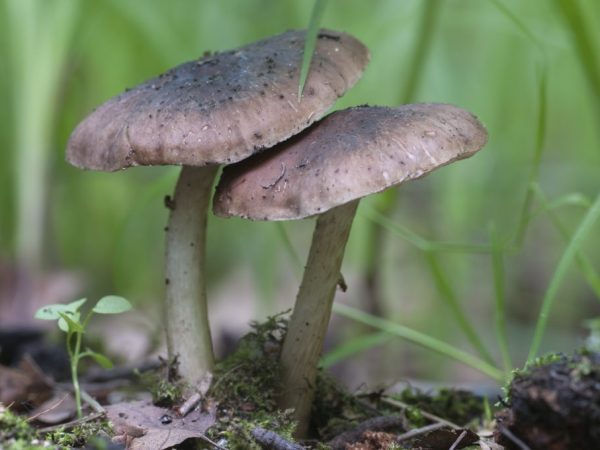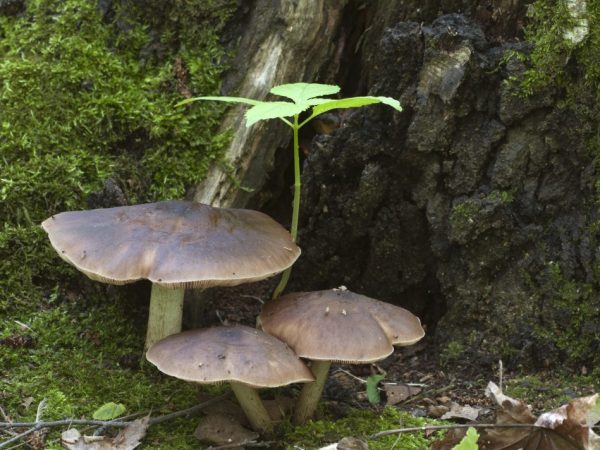Fungus mushroom and its varieties
The mushroom clowns belongs to the Pluthee family from the Agaricaceae order. It has other names - "pluteus" and "pluteus".

Fungus mushroom and its varieties
Morphological characteristics
Plutey belongs to saprotrophs. They destroy the dead remains of living organisms, turning them into the simplest organic and inorganic compounds.
The fruiting bodies of representatives of the Pluthee family are characterized by a hat-toed structure. The cap is easily detached from the leg and can be of different types: from bell-shaped to open. Often there is a tubercle in the center of the cap. The surface is glossy, smooth, often dry, but sometimes slimy, sometimes fibrous, silky or scaly. There are species in which the surface of the cap is wrinkled or covered with a mesh or veins.
Color - from white to almost black, but more often - brown or yellow. The sizes of mushroom caps vary depending on belonging to a particular species, and can be up to 1 cm in the smallest species and up to 20-24 cm in the largest species.
In translation, the Latin name of the mushroom means "shield".
The mushroom stem is cylindrical, often widened or tuberous at the base, it can be solid or hollow. The surface of the stem is without cover, fibrous or scaly. It has medium or large sizes, central or slightly asymmetrical in relation to the center of the cap.
The mushroom pulp is light, from white to yellow, fleshy, without changes in the cut. Has a faint smell and a mild taste. Some species have a bitter taste. The hymenophore is formed by white and pink free plates.
Varieties
Among the most common edible species are:
- Deer rods: it is believed to be eaten by deer. It also has a deer color - brown, for which it received such a popular name. Representatives of the species have a wide bell-shaped smooth cap with a weakly pronounced tubercle in the center, the pulp has a weak radish odor.
Irina Selyutina (Biologist):
Deer plute is considered the most widespread type of plute on the territory of the post-Soviet space. It is characterized by a white leg with black fibers, slightly swollen at the base. The hat is grayish-brown with stripes along the edge. The plates of young mushrooms are white, but as the specimen matures, they turn pink until they acquire a reddish-meaty color.
In the deer spit, varieties are known that differ in the color of the cap - fawn, ash-gray.
- Umber clown: it is a conditionally edible mushroom with a characteristic bitterness and rare odor, which disappear during heat treatment. The mushroom has a flat-convex or open wrinkled cap of a whitish or brown color with a radial or mesh pattern, granular ribs and a serrated fringe.
- Dark-Edge Plyutey: it has a thick-fleshed bell-shaped or semicircular cap and torn edges, painted in dark shades of brown. Pulp with a sweet taste and pleasant aroma.
- The lion-yellow rogue: the mushroom has a brightly colored yellow bell-shaped or flat-convex cap with translucent striped edges. It is considered a saprotroph that lives on semi-rotten wood in deciduous forests. Representatives of this species can be found even in northern Africa - Algeria and Morocco.
The species composition of the family and their description have been little studied - the exact number of varieties has not been established. Approximately 140-300 species are found in nature, of which only 50 are well studied.

There are several types of mushroom
Among the most famous inedible species are:
- The velvety-footed dummy: it has a thin velvety wrinkled brown cap, a semicircular or flat shape, thin edges, and often have pronounced grooves.
- Noble rogue: it is characterized by a thick-fleshed shiny, sometimes slimy cap, which has smooth or tucked edges and is white and gray in color.
- Dwarf rogue: its thin-fleshy cone-shaped cap with a clearly defined tubercle and a velvety surface is brown with olive color. Covered with a soot-powdery bloom.
Irina Selyutina (Biologist):
Plutey is a rather small dwarf fungus, distributed quite widely, but the species is still not well studied. The cap, reaching a maximum of 5 cm in diameter, is radially wrinkled, almost black in the center. Hymenophore plates are white at first, then gradually turn pink. The leg is whitish and more or less even
This saprotroph can easily be found on tree stumps, deciduous tree remains, deciduous and mixed forests, and even parks.
- Veinous cluck: It has a thin conical or outstretched cap with a wrinkled mesh surface and smooth edges. Color - amber shades of brown.
Geography of distribution
The predominant habitat is forest areas. Most varieties are found on soil containing woody debris, or on decaying wood, including stumps and dead wood. Less commonly, these mushrooms are found in gardens and parks. Sometimes they grow in greenhouses. In some cases, they are found on living, but rotten trees, leading to the appearance of white rot.
In the natural environment, representatives of the family have an important ecological function: they destroy dead wood.
The geography of distribution covers all continental areas with the exception of Antarctica. The greatest species diversity is presented in the deciduous forests of the Northern Hemisphere, where the substrate preferred by the fungus is sufficient. On the territory of Russia, the varieties found in the Rostov Region, Primorsky Territory, Leningrad and Samara Regions are well studied.
Practical use
Practical use of the mushroom is limited to a few edible species. Many varieties are rare, therefore, due to their poor knowledge, they are considered inedible. There are several species with hallucinogenic properties. They are caused by the psilocybin contained in the chemical composition. Such mushrooms include willow and n. Blue.
Certain varieties have a number of medicinal properties in chemical composition, including:
- deer roast: contains polysaccharides that inhibit the development of malignant tumors,
- dwarf fish: an extract obtained from the fruit bodies of representatives of this species has an immunostimulating effect.
Edible varieties are rarely eaten due to their mediocre taste.
Conclusion
The Pluteye family includes many species, among which there are edible (p. Lion-yellow, p. Deer, etc.) and inedible (p. Noble, p. Dwarf, etc.). The mushroom mushroom is rarely used for food due to its low gastronomic characteristics. Some varieties (p. Deer and p. Dwarf) are used as medicinal raw materials. Certain species (p. Willow, p.blue) have hallucinogenic properties.



